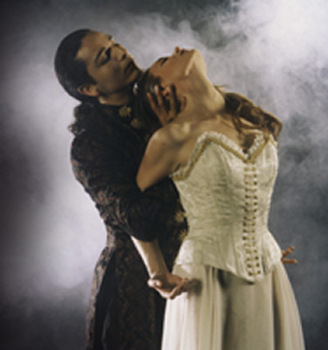
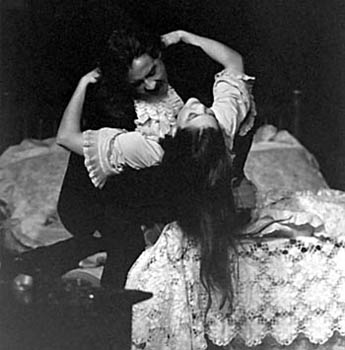
Dracula is the epitome of power and violence. He controls others, stereotypically women, for his own sadistic pleasure.
In the Victorian Era, and particularly in Dracula, there was a "common cultural myth concerning gender [that] asserts that men have difficulty controlling their aggressive, indulgent, destructive impulses" (Wyman and Dionisopoulos 33). Some of the popular images of Dracula movies, based off of Bram Stoker's Dracula, depict Vlad Dracula as frowning and a little scary looking. This look signifies someone who is aggressive and angry. The story tells us that he indulges in his desires for blood and for sex whenever he wishes. He has the ability to force himself on whatever woman he wishes because of his vampirism, he hypnotizes them with his eyes and they are basically under his command to do with as he pleases.
 |
This first picture of Dracula with a girl, where he is holding her arms back, depicts this power that he holds. The way her head is leaned back into him and her hands are opened with the palms up depict a sense of powerlessness within her. In the Victorian Age, there were "two primary characteristics" to mark the "Perfect Lady: submission to/support of the patriarch" (Jorgensen 84). The open, palms up hands portray the girl's openness to Dracula as she gives power of herself over to him in a portrayal of her submission. By leaning her head back toward him, the girl is elongating and exposing her neck. Because the vampire sucks blood from the neck, it is the most sensitive part of the body in this situation. The fact that she is exposing to Dracula the most sensitive part of her body, that is the cause of pain for humans when vampires are around, is indicative of the power he holds over her to make her do as he desires. |
 |
This second picture of Dracula with a girl is another image that
depicts his power. This girl is leaning away from him while her
arms are wrapped around him to hold him close to her. Her head is
thrown back helplessly, exposing her neck to him, as he leans in to
bite her. His face expresses rage and vampiric desire with his
mouth open in a fangy snarl and focused on her neck.
Dracula is the epitome of power and violence. He controls others, stereotypically women, for his own sadistic pleasure. |
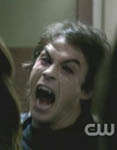 |
The pictures of the Salvatore brothers, from The Vampire Diaries, depict some of this violence. With bared fangs, red eyes, and highly visible veins in the face, I would be terrified to see this coming at me. This face is supposed to signal that the vampire has been overcome by desire, for blood or violence or lust, and is losing self-control. This loss of self-control always ends in violence, whatever the reason for the loss, and usually in the death of a human. Sometimes, it ends in the death of another vampire. | 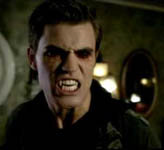 |
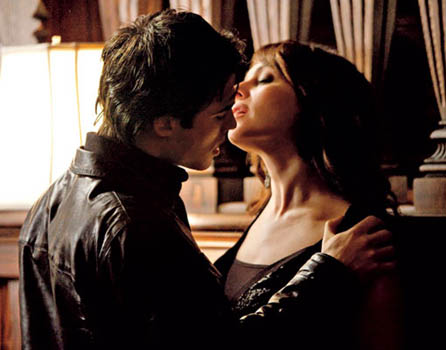 |
This image of Damon and an unnamed girl is evocative of his power. She is backed up against a wall, making it impossible for her to get away. He has compelled her not to be afraid of him and she will believe that she enjoys getting her neck bitten and her blood sucked by a vampire. Much like the girls with Dracula, she is offering her neck to him willingly and giving him the power over her. Once inside the mansion, Damon and the different girls will participate in all kinds of sexual debauchery as he drinks blood from their necks intermittently and at will. He does not need to practice self-control because the humans are powerless to defend themselves against him without prior knowledge of the history of the vampire legend. |
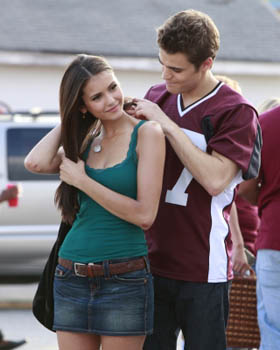 |
This image of Stefan with Elena actually depicts Stefan giving up his power to control Elena. The necklace he is placing around her neck is made of silver and filled with vervain. In the vampire myth, vervain is to vampires what kryptonite is to Superman. A human with vervain in their system or on their person would be immune to any vampire's gifts to compel them. By giving her this necklace, Stefan is basically giving up his power over Elena. He cannot hide things from her or convince her to do as he pleases any longer. And, because the necklace is made out of silver, a metal that burns vampires, he cannot remove it from her. At the time that he gives her this necklace, however, she brushes her hair aside to reveal her neck to him. By revealing her neck to him with the knowledge of what he is and what he could do to her, she is showing that she trusts him. |
| The image of Edward attacking another vampire is indicative of his violent capabilities. In this scene, Edward (the vampire pushing the other against the glass) has followed another vampire, James, who has kidnapped Bella. James has every intention of killing Bella and drinking all of her blood, but he is reveling in his ability to mess with Edward's mind, first, and is taking his time. Edward has chased him down and stops him before he can do any real damage to her. He is pretty pissed, though - very angry and aggressive and violent. The scene that ensues in the movie is full of action. The vampires are in a dance studio and they pretty well destroy the place during their fight. | 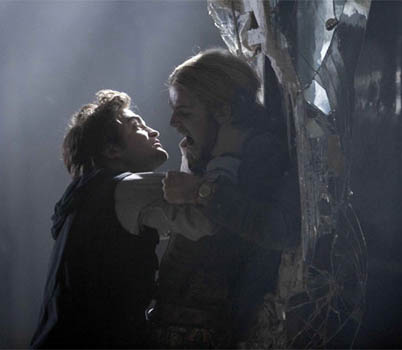 |
James has taken Bella because she "smells good" to him, her blood smells tastier than most humans. Even though he knew he had to steal her away from Edward and his large family, the promise of indulgence in blood that good was too much for James to even consider controlling. He is aggressive with his desires even when Bella is surrounded by Edward's vampire family intent on protecting her. James is depicted much like Damon from The Vampire Diaries. He does control himself and takes pleasure in his control of humans.
Edward, on the other hand, is depicted much like Stefan. He and his entire family drink animal blood instead of human blood and have placed themselves within the community of Forks as normal human beings that are vital to the society. They do still regularly exhibit aggression and violence, but against the animals they hunt in the forest instead of against humans. By placing himself in such close proximity to Bella, Edward must implement a huge amount of self-control to keep from killing her.
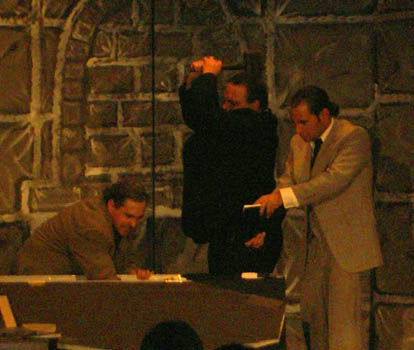 |
Males have also been portrayed as protectors throughout the
years. In the Victorian Era, however, it was the human males who
protected the females. Dr. Van Helsing is the most famous protector
from this story and he protects both males and females. His goal is
to annihilate the scourge of the vampire disease by killing it at
the source. Dracula is considered the source.
In this image, Van Helsing is teaching Dr. Seward and Jonathan Harker how to kill vampires. Van Helsing is the hero of the story who teaches the others how to protect themselves. In this particular scene, the men are killing Lucy after she has become a vampire. This scene shows how even the human males have violence in themselves as they drive a stake through Lucy's heart. In this case, however, these men are violent in order to protect other humans and not for their own pleasure. This distinction is what separates the male vampires from the male humans. |
 |
In the Twilight series, Edward uses his incredible strength to protect Bella. In this image, he has stopped her from being smashed between two cars during an accident in the school parking lot. He has wrapped his arm around her, holding her into him, and blocked the car with his other. His superhuman strength is evident in the large dent he has placed in the side of the blue car. When holding her close to him, not only is he saving her from the danger of the car but he is acting without thinking about how he has placed her in danger of himself because he could lose his self-control and attack her. |
| Another image from the Twilight series shows how Edward is constantly protecting Bella from dangers. The story says she feels safest in his arms. This picture shows this relationship as he is holding on to him just as tightly as he is holding on to her. The tight grip they hold on each other is indicative of the dangerous situations they have gone through together that he has saved her from. Because Edward has saved her life in the past, she can trust him to do it again if the situation arises. This stance also signifies how much he relies on her to be there. As the story goes, he would not live without her. In fact, when he thinks she has died he goes on a suicide mission and only Bella is able to stop him. | 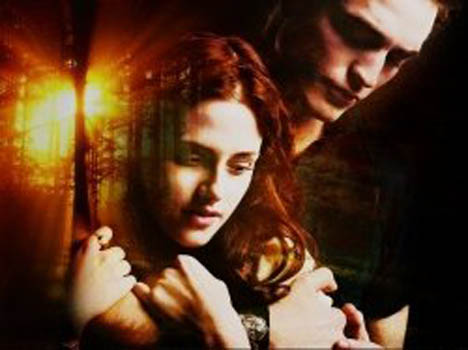 |
 |
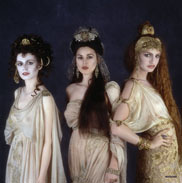 |
| Gender Roles | Feminine Roles |
| Works Cited on this page |
| Gillian, Rose. Visual Methodologies" An Introduction to the
Interpretation of Visual Materials. London; Thousand Oaks, CA; New
Delhi: SAGE Publications, 2007.
Jorgensen, Cheryl R. "The Lady, The Whore, and The Spinster: The Rhetorical Use of Victorian Images of Women." Western Journal of Speech Communication (1990): 82-98. Wyman, Leah M. and George N. Dionisopoulos. "Primal Urges and Civilized Sensibilities: The Rhetoric of Gendered Archetypes, Seduction, and Resistance in Bram Stoker's Dracula." Journal of Popular Film and Television (1999): 32-39. |